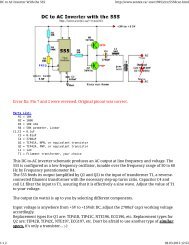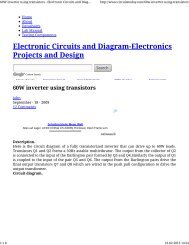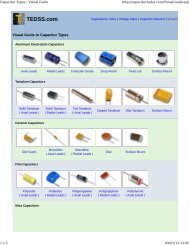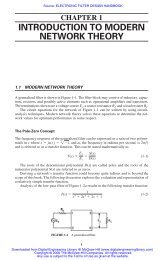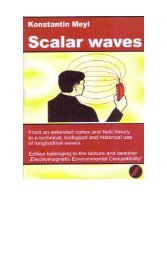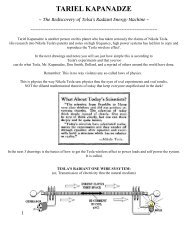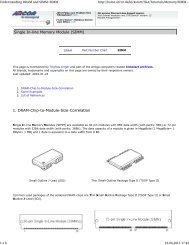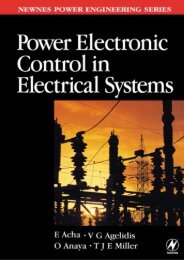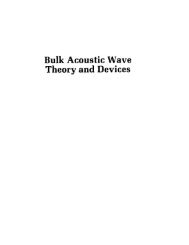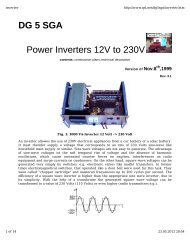New Energy Technologies Magazine nr 3 2005.pdf - Index of
New Energy Technologies Magazine nr 3 2005.pdf - Index of
New Energy Technologies Magazine nr 3 2005.pdf - Index of
You also want an ePaper? Increase the reach of your titles
YUMPU automatically turns print PDFs into web optimized ePapers that Google loves.
As it follows from the last expression, in the<br />
event that C B<br />
= C B1<br />
, in order to obtain boiling<br />
water at the outlet <strong>of</strong> the heater, it is necessary<br />
to get the initial temperature <strong>of</strong> the water<br />
subjected to the mechanoactivation <strong>of</strong> about<br />
T 1<br />
= 66.5C. This coincides with the results<br />
given in [3], [4], [5].<br />
Thus, the described heat effects allow obtaining<br />
a rather considerable additional heat generation<br />
Q exc<br />
in the generator’s work chamber.<br />
However, the very fact <strong>of</strong> presence <strong>of</strong> additional<br />
heat Q exc<br />
does not mean that it can be used for a<br />
considerable increase <strong>of</strong> the generator’s heat<br />
productivity.<br />
In order to make sure <strong>of</strong> this, let us consider<br />
two contours <strong>of</strong> hydro-dynamic generators’<br />
operation: the first contour is with a closed<br />
circuit <strong>of</strong> the actuating body’s circulation and<br />
the second one is with an open circuit.<br />
In the first contour, heat generation Q exc<br />
during<br />
the water change from the stable lowtemperature<br />
state to the metastable hightemperature<br />
one happens without a change <strong>of</strong><br />
total energy content <strong>of</strong> a system<br />
“heatgenerator – circuit”. During this, a heat,<br />
which was temporarily produced in the contour<br />
by the water in the phase change, will be<br />
absorbed again within the limits <strong>of</strong> the same<br />
contour by the water, which spontaneously<br />
returns in its initial low-temperature state after<br />
the relaxation time has passed.<br />
It is obvious that, in this case, the heat, which<br />
was first produced and then absorbed, is a kind<br />
<strong>of</strong> virtual heat and cannot change the<br />
generator’s productivity in such a way that its<br />
efficiency exceeds one.<br />
The operation <strong>of</strong> the heatgenerator with the<br />
closed contour is explained on Fig. 5.<br />
The countour <strong>of</strong> the actuating body <strong>of</strong><br />
heatgenerator 1 circulation consists <strong>of</strong> force<br />
electric pump 2 and heat exchanger 3 connected<br />
by hydro-pipes.<br />
Using the pump, a water with temperature T 1<br />
is led to the inlet <strong>of</strong> the heatgenerator, heated<br />
there up to temperature T 2<br />
, and led to the heat<br />
exchanger where it is cooled up to temperature<br />
T 1<br />
, and then it is led to the inlet <strong>of</strong> the<br />
heatgenerator again through the pump.<br />
A heating efficiency <strong>of</strong> the generator during<br />
time τ, as a rule, is determined by temperature<br />
drop ∆Т = Т 2<br />
– Т 1<br />
in the heat exchanger and<br />
water consumption G in the contour:<br />
Q = k ∆Т G τ (5),<br />
where k is an aspect ratio.<br />
The efficiency <strong>of</strong> the heatgenerator’s operation,<br />
excluding heat diffusion in the hydro-pipes and<br />
elements 1 and 2 <strong>of</strong> the contour, is evaluated by<br />
ratio<br />
η = Q / U, (6)<br />
where U is an electric energy consumed by the<br />
pump during time τ.<br />
However, evaluation (6) can be reliable just<br />
in the event when all heat Q produced by the<br />
generator is led to the environment, for<br />
example, to the consumer.<br />
Actually, as it follows from (3), heat Q is a sum<br />
<strong>of</strong> two components: the first, Q exc<br />
, is caused by<br />
the exothermic water change while the second,<br />
finally, is obtained by electric energy<br />
transformation U into heat ∆Q, which is<br />
equivalent to it. Durng continuous heat<br />
production <strong>of</strong> the generator, the consumer can<br />
obtain only a part <strong>of</strong> the heat, which is obtained<br />
via heat excange, i.e. it is possible to get heat<br />
∆Q, and always ∆Q U.<br />
Another part <strong>of</strong> heat Q, heat Q exc<br />
, is caused by a<br />
temporary heat production because, on the<br />
expiry <strong>of</strong> relaxation time τ r<br />
, this part <strong>of</strong> the heat<br />
is absorbed by the water again and is unavailable<br />
for the consumer.<br />
Hence, temperature drop ∆T in the heat<br />
exchanger cannot be used as a representative<br />
informative parameter for the evaluation <strong>of</strong><br />
the heatgenerator’s efficiency according to<br />
the diagram on Fig. 5.<br />
The mentioned drop is caused by two reasons: first,<br />
by the water cooling during the heat emission and,<br />
36 <strong>New</strong> <strong>Energy</strong> <strong>Technologies</strong> #3(22) 2005



